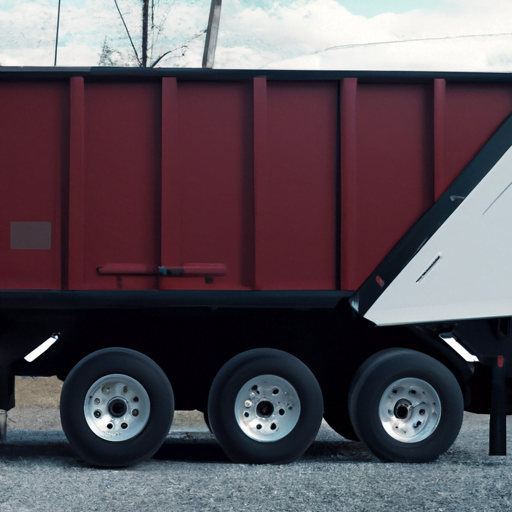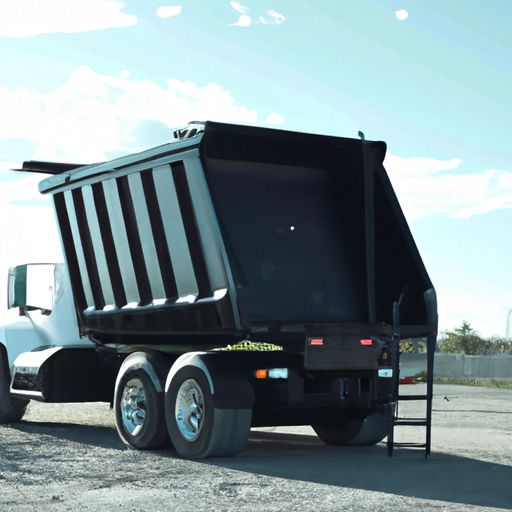-
Table of Contents
Introduction
Optimizing a heavy duty dump trailer to achieve maximum load involves several critical factors, such as proper weight distribution, tire maintenance, and structure integrity. This guide will offer strategic methods and practical tips on how you can enhance your dump trailer’s performance and durability while ensuring safety standards are met. From prioritizing regular inspections to understanding when your vehicle is overloaded, we’ll delve into all the measures necessary for optimizing your heavy-duty dump trailer effectively. It’s not just about maximizing capacity; it’s also about extending the lifespan of the equipment and maintaining operational efficiency in the long run.
Maximizing the Load Capacity: A Guide to Optimizing Your Heavy Duty Dump Trailer
When it comes to construction, landscaping or agricultural work, heavy-duty dump trailers are indispensable in transporting hefty materials from one place to another. More often than not, these behemoths are tasked with carrying full loading capacities; thus maximizing their load is crucial for efficiency and productivity. What if there were actionable strategies you could employ to optimize your trailer’s load capacity? Let’s dive straight in.
First off, it all begins by examining the specifics of your trailer. Every make and model has a different payload rating that stipulates the maximum weight it can transport safely. Always respect this figure – overloading can damage your trailer or even pose dangerous risks on the road like abrupt braking problems. An overloaded trailer causes more wear and tear leading to frequent maintenance needs hence disrupting regular operations.
Hand-in-hand with understanding payload ratings is correctly distributing the load across your dump-trailer bed. It might seem straightforward enough to dump everything at once into the middle of your rig but achieving ideal balance requires strategic planning indeed! Uneven distribution of weight leads to unstable towing situations possibly causing rollovers during transit which we do not want!
For optimal efficacy, aim towards creating a low center-of-gravity by loading heavier items first then layer them evenly downwards using lighter materials as much as possible without surpassing each axle’s Gross Axle Weight Rating (GAWR). This ensures safe transit while avoiding over-strain on any single axle that may lead up-to premature failure.
Another surefire way towards optimizing load capacity pertains directly back-to-the dumping process itself which many tend overlook: use tarp systems effectively cover loaded materials thereby reducing wind resistance increases fuel consumption also helps prevent loss smaller items en-route destination best practice regardless legal requirements certain jurisdictions necessitate covering loads for environmental protection purposes safety measures against potential debris impact other motorists commercial truck drivers will attest benefits having professional-quality automated system prefer manual option ensure thoroughly secure before hitting road again saving time money long run !
Moreover, regular maintenance checks should never be skipped. Similar to how an automobile requires routine service for optimal performance, your dump trailer shouldn’t be any different. Conducting preventative maintenance on your suspension system ensures that the axles and springs can continue supporting maximum loads without buckling under pressure.
Lastly, but certainly not least in importance, is considering the overall condition of your tires. A huge part of maintaining a safe and efficient load capacity involves keeping tabs on tire health as deflated or worn-out tires increase chances of blowouts or flat-tires during transit causing unnecessary delays and potential damages.
With these strategies up your sleeve, optimizing the load bearing capabilities of your heavy-duty dump trailer becomes less daunting a task than you might have perceived it as initially. The key takeaways are: respecting payload ratings; efficiently distributing weight; strategic use of tarp systems; routine inspections complemented with preventive maintenance measures and lastly—meticulous attention towards tire-condition are pivotal elements culminating towards optimized efficiency – both in terms transporting more materials per trip also significantly enhancing lifespan your utility equipment!
Three Key Strategies for Achieving Maximum Load in Your Heavy Duty Dump Trailer
Optimizing your heavy-duty dump trailer to handle maximum load is not just about the capacity of the vehicle. It also entails strategically taking precautions and making adjustments that promote efficiency, safety, and longevity. Perfecting these nuances can help you achieve exceptional output with unrivaled effectiveness. We’ll be exploring three key strategies which will ensure optimal performance from your heavy duty dump trailer.
The first strategy revolves around maintaining a regular check on your dump truck’s tire pressures. Keeping all tires properly inflated plays an essential role in maximizing load capacity while minimizing wear and tear caused by constant friction between the dumpster’s wheels and road surface. Underinflated tires reduce fuel efficiency and handling, adversely affecting the payload capabilities of your trailer. A rule-of-thumb recommendation would be to check tire pressure at least weekly or every other day depending on usage frequency.
Progressing along our exploration, it half surprises no one that weight distribution ranks high among crucial considerations when aiming for superior productivity with a heavy-duty dump trailer. Properly balancing out weight across all axles aids in avoiding overloading certain parts of the truck or its suspension system hence extending its lifespan and fostering operational safety as well.
To effectively distribute weight, endeavor to place heavier materials in the middle part—the core—of your payload before sprinkling lighter items around it forming something akin to a ‘weight sandwich’. By doing this, you’re helping balance out forces acting upon individual components ensuring each takes only what they are designed for hence boosting overall performance capability.
A noteworthy mention here though regards occasionally checking manufacturer guidelines on axle loading limits which if regularly exceeded could cause severe mechanical problems down-the-line perhaps even legal issues considering local transportation codes typically stipulate limits too regarding axle weights allowed per vehicle type being used.
Our final point touches upon periodic maintenance – often glossed over but exceedingly vital aspect concerning any machinery let alone heavily relied-upon equipment like industrial trailers intended for demanding jobs somewhat regularly pushed to their operating limits.
Regularly scheduled maintenance activities allow for better detection of small issues before they morph into substantial problems. Actions such as frequently lubing moving parts, checking brakes and lights, inspecting the body for possible cracks or rust not only uphold your trailer’s integrity but also contribute to its overall work output by ensuring seamless operation that’s unhindered by avoidable breakdowns which cost time and money to fix.
Bottom line here is that prevention always proves cheaper than cure – take deliberate steps earlier on in identifying potential trouble spots and promptly fixing them you’ll end up saving yourself a major headache later when least expected or fit into your schedule particularly if during peak business periods when any downtime could translate directly into lost revenue opportunities!
In conclusion, extracting maximum productivity from your heavy-duty dump trailer isn’t rocket science, it simply demands consistent attention paid towards tire pressures, weight distribution strategies coupled with regular preventative maintenance routines. Armed with these key strategies expect enhanced operational performance plus prolonged lifespan out of your dependable workhorse ultimately yielding superior returns on investment!
Unleashing the Full Potential of Your Heavy Duty Dump Trailer: Tips for Optimal Load Optimization
When you think about a heavy-duty dump trailer, what comes to mind? The image of a robust piece of machinery designed for high-intensity tasks is probably foremost in your thoughts. However, even the toughest machinery has its limits and optimizing their full potential can be crucial. In this regard, understanding how to efficiently manage and maximize the load capacity of your dump trailer is not merely beneficial – it’s paramount.
The concept involved here isn’t complex: using space strategically without exceeding weight capacities can ensure optimal performance from your heavy-duty dump trailer. But doing this successfully requires best practice knowledge.
First off, begin with understanding that every trailer possesses a Gross Vehicle Weight Rating (GVWR). This encompasses the maximum combined weight allowance for both the vehicle itself and the cargo it’s carrying – so when loading up materials or debris into your dump truck bed, bear this figure firmly in mind.
Next on deck is spacing out loads evenly across all axles. The majority of trailers feature multiple axles which share total load capacity between them; balancing weights effectively avoids overburdening any one axle while underutilizing others. Just like supporting players on a sports team sharing responsibility improves overall results – equally distributing load does wonders for extending equipment lifetime while reducing chances at breakdowns during transportation runs.
A third important aspect to consider involves managing vertical space wisely within your heavy-duty dump trailer. It might seem tempting to stack high and save time by fitting more items per trip but resisting such an urge will pay dividends down the line! Overloading materials above side walls may expose drivers behind you to incidental hazards due physical shifts during travel course changes or sudden braking actions!
Understanding these nuances regarding maximizing potential load optimization serves as step number one towards reaping most benefits from owning powerful vehicles such as heavy-duty dumping trailers – but there’s more still worth considering too!
For instance, adopting regular preventative maintenance checks and services into operations schedule extends vehicle life spans dramatically through early detection of potential failures before these become large-scale issues. It’s the equivalent of a man receiving regular health checkups – ensuring years more vitality and efficiency.
Moreover, consider investing in high-quality components for your dump trailer from reputable suppliers. These parts will likely withstand heavier loads better than their cheaper counterparts, helping prevent equipment failure while boosting overall performance. Think about upgrading tires to handle increased cargo weights or replacing older hydraulic systems with more robust models too.
And lastly, remember it’s crucial to train operators comprehensively on best practices when loading heavy-duty dump trailers – thus further enhancing load management tactics and avoiding unnecessary damage that compromises vehicle longevity or operational safety aspects!
In summary – optimizing a heavy-duty dump trailer isn’t just about filling it up to the brim; it involves understanding its capabilities as well as knowing how to distribute weight evenly for efficient operation. Through informed decision making coupled with preventative maintenance actions and smart investment into quality components one can truly maximize their return asset utilization in this instance indeed!
Q&A
1. Question: What steps can be taken to optimize a heavy duty dump trailer for maximum load?
Answer: The first step involves proper weight distribution, which requires loading the trailer uniformly and balancing the weight evenly across all axes. Secondly, regular maintenance checks including tire pressure checks, brake system inspection, and ensuring suspension systems are in optimal condition is crucial. Lastly, using high-quality materials while constructing or choosing a dump trailer that can withstand pressure without corroding or wearing out quickly would improve capacity.
2. Question: What role does regular maintenance play in optimizing a heavy duty dump trailer?
Answer: Regular maintenance plays an essential role as it ensures all parts of your dump trailer function optimally and safe from mechanical failures during operation. It includes checking the state of tires for wear and maintaining correct inflation levels, inspecting hydraulic systems for any leaks or faults, regularly lubricating moving parts to reduce friction damage, servicing brakes system often to ensure they’re reliable under heavy loads.
3. Question: How do I safely maximize the payload capacity of my heavy-duty dump trailer?
Answer: To safely maximize payload capacity you should not exceed manufacturer’s recommended gross vehicle weight rating (GVWR). Appropriately distribute your cargo throughout the entire space available within the dumping compartment – heavier items at bottom & balanced on both sides. Additionally maintain optimal tire pressures according to manufacturers’ recommendations since improper tire pressure could affect handling; lowering safety margins especially when vehicle is loaded maximally.
Conclusion
In conclusion, to optimize your heavy duty dump trailer for maximum load capacity, it’s essential to regularly maintain and inspect the trailer for any damages or wear. It is equally important to balance the load appropriately across the trailer, not exceeding its gross vehicle weight rating (GVWR), to prevent excessive strain on one part which could lead to accidents or fast deterioration of parts. Furthermore, choosing high-quality materials for construction can enhance durability and strength while reducing dead weight, optimizing fuel efficiency. Finally, tailoring your rig configuration according to specific job requirements can also help achieve maximum utilization of space and carry more loads efficiently.


